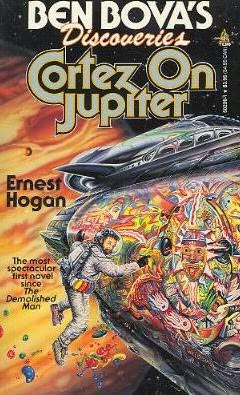 Blueprint For A Prophet (1997)
Blueprint For A Prophet (1997) Carl Gibeily
I forget where I picked this book up. Given that I have the hardback edition, I suspect it was in some publishers' clearance shop. Why I bought it... Well, the author was unknown to me, and the book wasn't published as science fiction... It must have been the story. But I'm glad I did buy it and read it. Blueprint For A Prophet is set in Lebanon (Gibeily is Lebanese) and describes the rise of a fundamentalist prophet who knits together the Arab states into a powerful Muslim federation. But it's not just about that, because one character is a theoretical physicist whose experiments could change history... Blueprint For A Prophet is one of those sf novels written by a non-sf writer which succeeds as science fiction.
The War for Eternity (1983)
Christopher Rowley

"Classic" is not a word usually associated with Christopher Rowley's novels. His prose is usually little better than competent. But his debut novel is much better. The War for Eternity is set on the world of Fenrille, which contains a single continent ringing its equator, and is the source of a longevity drug. The drug is harvested from insectoid creatures native to Fenrille, but only certain people are permitted by them to do the harvesting. It's a similar idea to that in CJ Cherryh's Serpent's Reach, although that's the only similarity between the two books. In The War for Eternity, forces from Earth attempt to seize control of Fenrille, but are fought off by the colonists. The story also takes a final bizarre twist at the end. Rowley went on to write a further three novels set in the same universe - The Black Ship, The Founder and To a Highland Nation.
 Cortez on Jupiter (1990)
Cortez on Jupiter (1990) Ernest Hogan
According to the cover of this novel, Cortez on Jupiter is "the most spectacular first novel since The Demolished Man". The Encyclopedia of Science Fiction described Hogan as "a figure of interest for the 1990s". Unfortunately, he had one more novel published, High Aztec (1992), and then dropped out of sight. Which is a shame. Cortez on Jupiter is an early post-cyberpunk novel about a graffiti artists who ends up making humanity's first contact with the sentient inhabitants of Jupiter. The flamboyant prose throws off ideas on every page, and the story is a rush from start to finish.
The Krugg Syndrome (1988)
Angus McAllister

This has to be one of the most mis-marketed books ever. From the cover, you'd expect something from the heartland of the genre, featuring strange expeditions to alien worlds. Instead, what you get is a comedy set in Glasgow in which a law clerk thinks he is an alien. Arthur Montrose is convinced he is a Krugg, one of a race of telepathic alien trees who are bent on conquering Earth. Unfortunately, he's lost his telepathic powers and can no longer contact his home world... The Krugg Syndrome is a diary of Arthur's experiences on Earth, the people he meets, his encounters with alcohol and sex, and his increasing inability to fulfill his Krugg mission...

The Morphodite trilogy (1981 - 1985)
MA Foster
The Morphodite is an artificially created humanoid with the ability to change its appearance, with each transformation changing sex and appearing younger. However, the Morphodite's real talent lies in spotting a society's fracture points - i.e., places where the ramifications of one small action can spiral out until they bring down the society. In the first book in the series, The Morphodite, the eponymous character is created in The Mask Factory on the world of Oerlikon, escapes, and promptly wreaks its revenge. In Transformer, the authorities have tracked down the Morphodite and send assassins to kill it. The Morphodite learns that it was originally a woman from offworld. Now knowing its original identity, it leaves Oerlikon for the world of Teragon. Preserver is set on that world many years later. A young man, who works as a thug/assassin for hire, learns when his lover is kidnapped that he is the Morphodite. He then uses his powers to destroy Teragon's society. There's something very Vancian about Foster's prose in these novels, although the central premise and its treatment is not in the slightest bit like Jack Vance. The three books were re-issued in an omnibus edition as The Transformer Trilogy.
Part one of "Overlooked Classics" is here.


1 comment:
I named one of the characters in my story "Dusk" in the Nova Scotia anthology, Krugg, as a deliberate reference to "The Krugg Syndrome" as I too felt it had been sadly neglected. It also had a dismissive review in Interzone which said it wasn't SF, which, of course it is.
Jack Deighton
Post a Comment